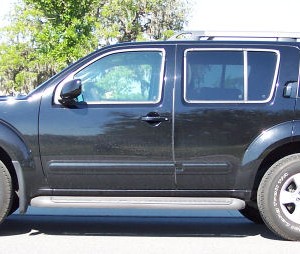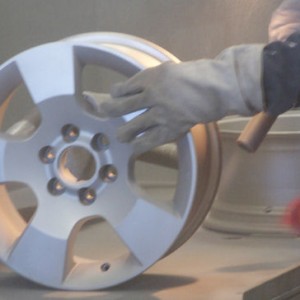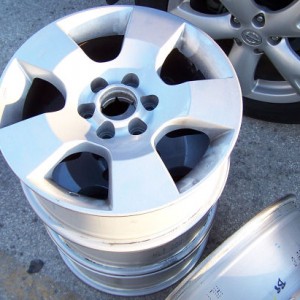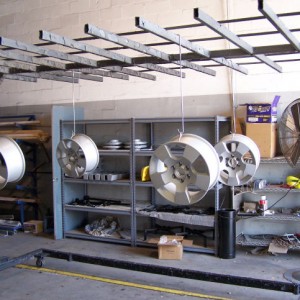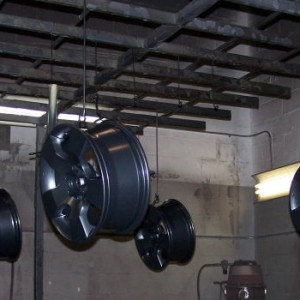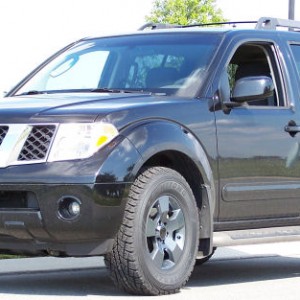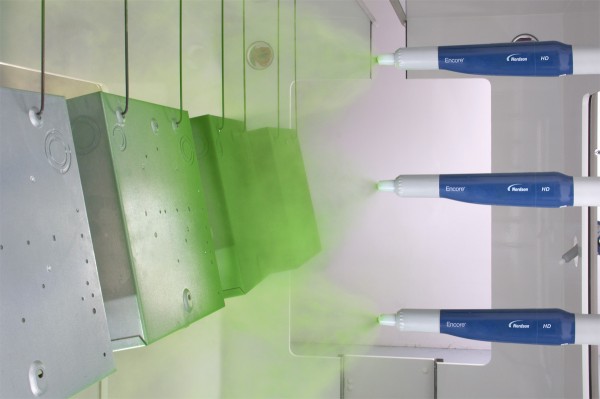 The powder coating process involves three basic steps:
The powder coating process involves three basic steps:
- Part preparation or the pre-treatment
- The powder application
- Curing
Part Preparation Processes and Equipment
Removal of oil, soil, lubrication greases, metal oxides, welding scales etc. is essential prior to the powder coating process. It can be done by a variety of chemical and mechanical methods. The selection of the method depends on the size and the material of the part to be powder coated, the type of soil to be removed and the performance requirement of the finished product.
Chemical pre-treatments involve the use of phosphates or chromates in submersion or spray application. These often occur in multiple stages and consist of degreasing, etching, de-smutting, various rinses and the final phosphating or chromating of the substrate. The pre-treatment process both cleans and improves bonding of the powder to the metal. Recent additional processes have been developed that avoid the use of chromates, as these can be toxic to the environment. Titanium zirconium and silanes offer similar performance against corrosion and adhesion of the powder.
In many high end applications, the part is electrocoated following the pretreatment process, and subsequent to the powder coating application. This has been particularly useful in automotive and other applications requiring high end performance characteristics.
Another method of preparing the surface prior to coating is known as abrasive blasting or sandblasting and shot blasting. Blast media and blasting abrasives are used to provide surface texturing and preparation, etching, finishing, and degreasing for products made of wood, plastic, or glass. The most important properties to consider are chemical composition and density; particle shape and size; and impact resistance.
Silicon carbide grit blast medium is brittle, sharp, and suitable for grinding metals and low-tensile strength, non-metallic materials. Plastic media blast equipment uses plastic abrasives that are sensitive to substrates such as aluminum, but still suitable for de-coating and surface finishing. Sand blast medium uses high-purity crystals that have low-metal content. Glass bead blast medium contains glass beads of various sizes.
Cast steel shot or steel grit is used to clean and prepare the surface before coating. Shot blasting recycles the media and is environmentally friendly. This method of preparation is highly efficient on steel parts such as I-beams, angles, pipes, tubes and large fabricated pieces.
Different powder coating applications can require alternative methods of preparation such as abrasive blasting prior to coating. The online consumer market typically offers media blasting services coupled with their coating services at additional costs.
Powder Application Processes
The most common way of applying the powder coating to metal objects is to spray the powder using an electrostatic gun, or corona gun. The gun imparts a positive electric charge to the powder, which is then sprayed towards the grounded object by mechanical or compressed air spraying and then accelerated toward the workpiece by the powerful electrostatic charge. There are a wide variety of spray nozzles available for use in electrostatic coating. The type of nozzle used will depend on the shape of the workpiece to be painted and the consistency of the paint. The object is then heated, and the powder melts into a uniform film, and is then cooled to form a hard coating. It is also common to heat the metal first and then spray the powder onto the hot substrate. Preheating can help to achieve a more uniform finish but can also create other problems, such as runs caused by excess powder. See the article “Fusion Bonded Epoxy Coatings”
Another type of gun is called a tribo gun, which charges the powder by (triboelectric) friction. In this case, the powder picks up a positive charge while rubbing along the wall of a Teflon tube inside the barrel of the gun. These charged powder particles then adhere to the grounded substrate. Using a tribo gun requires a different formulation of powder than the more common corona guns. Tribo guns are not subject to some of the problems associated with corona guns, however, such as back ionization and the Faraday cage effect.
Powder can also be applied using specifically adapted electrostatic discs.
Another method of applying powder coating, called the fluidized bed method, is by heating the substrate and then dipping it into an aerated, powder-filled bed. The powder sticks and melts to the hot object. Further heating is usually required to finish curing the coating. This method is generally used when the desired thickness of coating is to exceed 300 micrometres. This is how most dishwasher racks are coated.
Electrostatic Fluidized Bed Boating
Electrostatic fluidized bed application uses the same fluidizing technique and the conventional fluidized bed dip process but with much less powder depth in the bed. An electrostatic charging medium is placed inside the bed so that the powder material becomes charged as the fluidizing air lifts it up. Charged particles of powder move upward and form a cloud of charged powder above the fluid bed. When a grounded part is passed through the charged cloud the particles will be attracted to its surface. The parts are not preheated as they are for the conventional fluidized bed dip process.
Electrostatic Magnetic Brush (EMB) Coating
A coating method for flat materials that applies powder with a roller, enabling relative high speeds and accurate layer thickness between 5 and 100 micrometre. The base for this process is conventional copier technology. Currently in use in some coating applications and promising for commercial powder coating on flat substrates (steel, aluminium, MDF, paper, board) as well in sheet to sheet and/or roll to roll processes. This process can potentially be integrated in an existing coating line.
Curing
When a thermoset powder is exposed to elevated temperature, it begins to melt, flows out, and then chemically reacts to form a higher molecular weight polymer in a network-like structure. This cure process, called crosslinking, requires a certain temperature for a certain length of time in order to reach full cure and establish the full film properties for which the material was designed. Normally the powders cure at 200°C (390°F) for 10 minutes. The curing schedule could vary according to the manufacturer’s specifications. The application of energy to the product to be cured can be accomplished by convection cure ovens, infrared cure ovens, or by laser curing process. The latter demonstrates significant reduction of curing time.
A Recent Project: Powder coat stock Nissan Pathfinder rims
- Step 1: Remove rims from vehicle, unmount tires, and remove any plastic/stickers/weights.
- Step 2: Prepare surface. This may include washing with a biodegradeable cleaner or alkaline cleaner, media blasting (shown), and blown clean
- Step 3: Hang parts on carts ensuring a good ground path for the static charge
- Step 4: Spray powder onto parts and bake in the curing oven per manufacturer’s instructions
- Step 5: Reinstall onto vehicle and enjoy.


